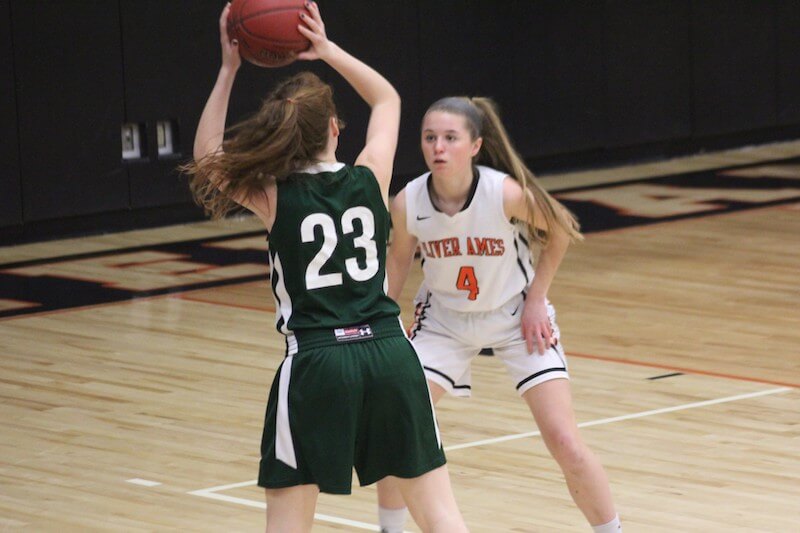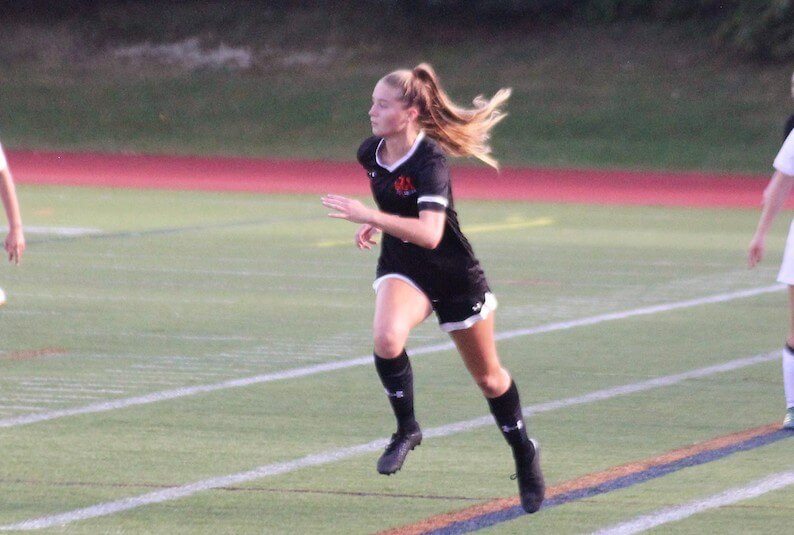This post was originally published on Thriving, Boston Children’s Hospital’s pediatric health blog.
It started with muscle aches in her shoulders, almost like spasms, while she slept. The pain was awful, and nothing seemed to bring relief. But because Erin Holmberg is a varsity three-sport athlete—soccer, basketball and track—everyone assumed it was muscular pain caused by overexertion.
Oddly, the pain miraculously disappeared during the day, only to return at night, as soon as she lay down to sleep. “We tried everything,” says her mom, Paula. “We got her a new mattress and new pillows. She tried stretching. We took her to the doctor. Finally, we got a neck pillow and that seemed to help.”

Sleepless nights, no answers
Starting in December 2018, the pain became much worse, causing Erin several sleepless nights. They took her back to the doctor, who prescribed physical therapy (PT).
“We scheduled PT for the following week, since that was the soonest we could get in,” says Paula. “But that night she wasn’t able to sleep at all.” Despite her lack of sleep, Erin got up and went to school and basketball practice. “When I called the doctor, she told me if it happened again we should take Erin to our local emergency room.”
That evening, when the pain started again, that’s where they went. “The doctors in the local emergency room thought it was clear the pain was muscular in nature and she didn’t need an MRI,” says Paula. “We could tell from Erin’s face the pain was unbearable, but they just gave her a pain reliever and sent us home.”
The next morning, Erin was in school by 9:30. She had a basketball game that night and couldn’t play if she didn’t attend school that day. During the game, Erin felt a different sensation, almost like her arms were going numb. That night she actually got some sleep, which Paula attributes to sheer exhaustion.

The following night, Paula and Erin attended a Christmas party at a friend’s house. While at the party, Paula spoke with another mother, who happened to be a pharmacist. “She told me if Erin was having numbness in her neck and arms, I should take her right to the Boston Children’s Hospital emergency room.”
Finally, a diagnosis
That night, after the party, the pain continued to get worse, so Paula and Erin drove into Boston and arrived in the emergency room at Boston Children’s at about midnight. After an evaluation overnight, they were seen by Catherine Perron, MD. “I was relieved because Dr. Perron saw the amount pain Erin was in and pushed for an MRI,” says Paula. “The MRI took about three hours, and when Dr. Perron finally came out and told me they found a tumor in Erin’s spine, I was in such shock that I asked her to explain it to Erin.”
Dr. Perron later mentioned to Erin’s father, Bob, that she couldn’t stop thinking about the question Erin asked her right after she was told about the tumor: “Is it growing inside me right now?”
While the family was happy to finally learn what was causing Erin’s pain, it was a frightening diagnosis. “I knew it wasn’t muscular pain, but I was surprised to learn it was so serious,” says Erin. “What worried me most was not knowing if it was cancerous or benign.”
Dr. Perron explained they would need to perform a biopsy to find out if the tumor was cancerous. She referred the family to Edward Smith, MD, pediatric neurosurgeon at the Dana Farber/Boston Children’s Cancer and Blood Disorders Center, to schedule surgery.
When they met with Dr. Smith, he explained the tumor was in a delicate area of the spine that controls movement and sensation in the arms, legs and neck. A lot of the tumor was intertwined with nerves. “He said the goal of surgery would be to relieve the pressure the tumor was putting on the spinal cord and remove as much of the tumor as safely possible without damaging any of the surrounding nerves,” says Paula.

He also told them about the risks of surgery, including permanent side effects on the nerves, like balance issues, motor skills, and tingling sensations in the arms and legs. There was a possibility she would not be able to continue her active lifestyle or play the sports she loved. “Not knowing how or if she would fully recover after a surgery like this was terrifying,” says Bob. “But if we did nothing, she could wake up one morning paralyzed, so the choice was pretty clear.”
Although the surgery didn’t need to be done right away, the family wanted the tumor removed as soon as possible. “Luckily, Dr. Smith was able to schedule surgery the next week, on December 21,” says Paula.
A successful surgery and Christmas homecoming
When Dr. Smith met with the Holmbergs right after surgery, he estimated he had removed at least 60 percent of the tumor, and was sure he relieved a lot of the pressure on Erin’s spinal cord, which would alleviate her pain.
The next day, after a post-op MRI, the Holmbergs received even better news. “After reviewing the MRI, Dr. Smith estimated he had actually removed 99 percent of the tumor,” says Paula. “It was like a miracle. That was an emotional moment for us. We had so many people praying for Erin. We know that must have helped in some way.”
Erin was discharged Christmas afternoon, earlier than expected, just in time to spend the evening with her family at her grandma’s house. “Between her diagnosis and the surgery, the only thing that kept us from totally losing it was knowing we were in the absolute best place in the world for her care,” says Bob. “I knew the advice we were getting was the best available.”
A few weeks later, the Holmbergs learned the tumor was a low-grade glioma, a type of tumor typically found in the brain, but which can also show up in the spinal cord.
Getting back on the field for spring soccer
Since the surgery, Erin has been doing well. “The only thing the surgery affected is my right arm and tingling in my legs—I lost the feeling in my right hand, but it’s slowly coming back with PT. For now, I had to teach myself how to write with my left hand.”
After a follow-up visit, she’ll learn if the remaining tumor has grown or if she needs any additional treatment. “It’s likely she’ll need to have follow-up MRIs forever,” says Paula.

As an athlete, Erin is excited to get back to sports. She’s an Enterprise All Scholastic Soccer Player, and a co-captain for her soccer team. She is a starting guard on her varsity basketball team and was also one of the top 400-meter runners for her track team at Oliver Ames High School in Easton, Massachusetts.
A few weeks ago, Erin returned to the field with her club soccer team. “Just watching her take the field was an emotional moment for us … but then, she scored the tying goal of the game,” says Bob. “It was amazing. Even her coach said he had tears in his eyes when she scored that goal.”
